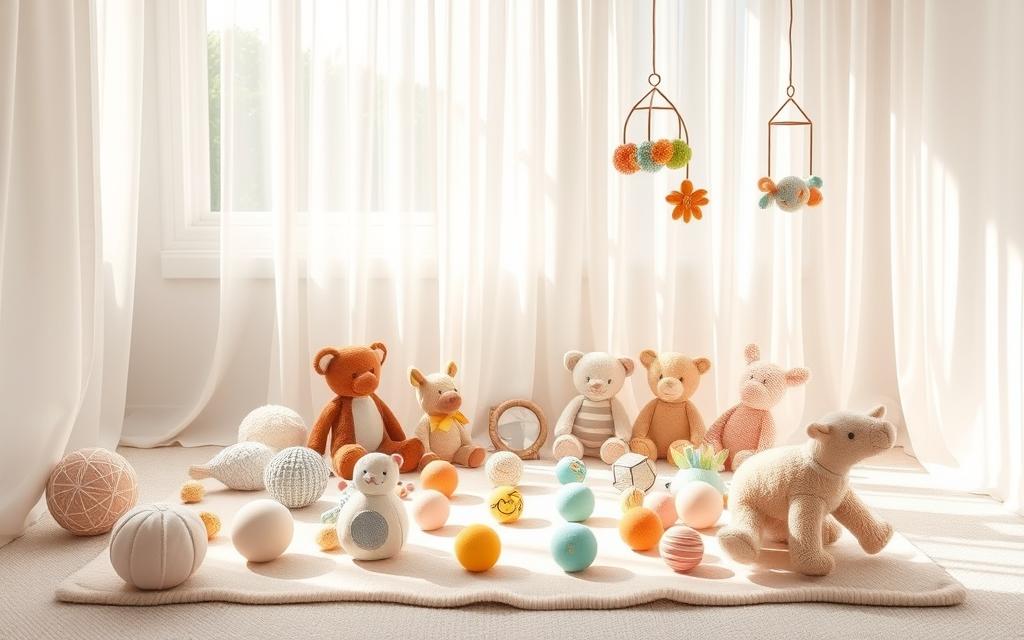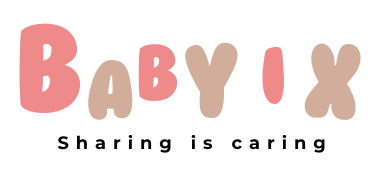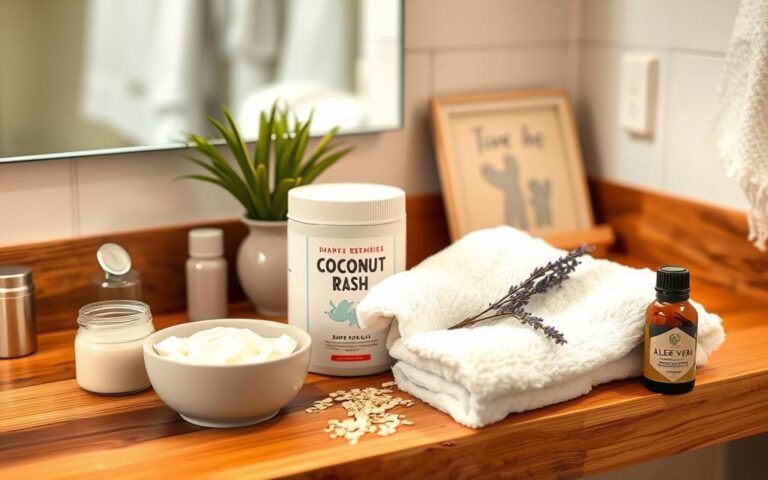Fostering Infant Sensory Development: Essential Tips for New Parents

Welcome to our guide on fostering infant sensory development. We’ll explore why it’s key for new parents to understand. Sensory development is vital for how babies see and interact with their world. It helps them learn and grow.
The first year is when sensory development really matters. It sets the stage for their future skills. As a new parent, knowing about sensory development is key. It helps you support your baby’s growth.
Key Takeaways
- Infant sensory development is critical in the first year of life
- Fostering infant sensory development supports future cognitive, motor, and emotional skills
- Infant sensory stimulation helps shape their perception of the world
- New parents play a vital role in supporting their baby’s sensory growth
- Understanding sensory development is essential for providing a strong foundation for future learning and development
- Fostering infant sensory development can be achieved through various activities and techniques
Understanding the Foundations of Infant Sensory Development
Infant sensory development starts at birth. Babies are born with seven senses: sight, sound, touch, taste, smell, balance, and body awareness. These senses help them understand and explore their world. By doing sensory activities, parents can help their babies grow and learn.
Studies show that sensory development is key for learning. It helps the brain develop important skills like thinking, moving, and feeling. This process is vital for babies to know who they are and their place in the world.
The Seven Sensory Systems in Infants
- Sight: the ability to see and interpret visual information
- Sound: the ability to hear and interpret auditory information
- Touch: the ability to feel and interpret tactile information
- Taste: the ability to taste and interpret gustatory information
- Smell: the ability to smell and interpret olfactory information
- Vestibular (balance): the ability to sense movement and balance
- Proprioception (body awareness): the ability to sense the position and movement of the body
Knowing about the seven senses helps parents create a good environment for their babies. They can do this by playing with different textures, listening to music, and moving around. This way, parents support their child’s growth and prepare them for learning in the future.
The Role of Parents in Sensory Development
Parents are key in helping infants grow their senses. They do this by playing and giving their babies new experiences. Activities like bath time, mealtime, and playing outside are great for this.
Here are some ways parents can help their infant’s senses grow:
- Give them different textures, like soft toys, rough blankets, and play dough
- Play music and move around together, like dancing and clapping
- Introduce new tastes and smells, like pureed fruits and veggies
By focusing on sensory development, parents can make a safe and supportive space for their baby. This helps their baby learn and explore in a fun way. It’s all about giving them a wide range of infant sensory experiences.
Creating an Optimal Environment for Sensory Growth
It’s key to boost infant sensory processing for their growth. Parents can make a rich sensory environment. This involves adding textures, colors, sounds, and smells to daily play.
When making sensory spaces, safety is first. Make sure the area is safe and the child is watched all the time. Important tools for sensory play include:
- Textured balls and toys
- Colorful fabrics and materials
- Sensory mats and playsets
- Music and sound equipment
Setting Up Sensory-Rich Spaces
Offering various sensory experiences helps in development. For instance, a sensory bin with rice or beans is great for touch. Music players with different tunes can engage the ears.
Safety Considerations for Sensory Activities
Safety is key in sensory play. Always watch the child and keep the area safe. This way, parents can help their child grow and improve their senses.
| Sensory Experience | Benefits |
|---|---|
| Textured balls and toys | Develops tactile awareness |
| Colorful fabrics and materials | Stimulates visual development |
| Sensory mats and playsets | Enhances sensory integration |
Tactile Stimulation: Touch-Based Activities for Babies
Touch is one of the first senses babies develop in the womb. It remains key in sensory development in newborns. From birth, babies use touch to explore and communicate with caregivers. Infant sensory stimulation through touch is vital for their growth.
Here are some touch-based activities for parents to enjoy with their babies:
- Massage: gently massaging the baby’s skin can help stimulate their sense of touch and promote relaxation.
- Skin-to-skin contact: holding the baby against the parent’s bare chest can help the baby feel secure and comforted.
- Textured toys: providing the baby with toys of different textures can help stimulate their sense of touch and encourage exploration.
By adding these touch-based activities to their daily routine, parents can support their baby’s sensory development in newborns. This also promotes healthy infant sensory stimulation. It positively impacts the baby’s overall development and well-being.
| Activity | Benefits |
|---|---|
| Massage | Promotes relaxation and stimulates sense of touch |
| Skin-to-skin contact | Helps the baby feel secure and comforted |
| Textured toys | Stimulates sense of touch and encourages exploration |
Visual Development: Enhancing Your Baby’s Sight
Visual development in infancy is amazing, with big steps taken in the first year. Parents can help a lot by playing and interacting with their babies. Using infant sensory play ideas in daily life can support healthy eye growth.
Creating a colorful and varied environment is key. This can be done with infant sensory play ideas like showing pictures of faces and objects. Then, introduce more complex patterns and colors. Activities like eye-tracking games and distance games also help.
- Color and pattern recognition: Show babies pictures of different colors and patterns to help them recognize and differentiate between them.
- Distance and depth perception: Play games that challenge babies to track objects moving at different distances and speeds.
- Eye-tracking exercises: Move a toy or object slowly in front of the baby’s face to help them track it with their eyes.
By adding these activities to daily play, parents can boost their babies’ visual skills. Always watch and play with your baby to keep them safe and happy.
| Activity | Age | Benefits |
|---|---|---|
| Color and pattern recognition | 6-12 months | Enhances visual perception and cognitive development |
| Distance and depth perception | 9-12 months | Improves eye-tracking and visual coordination |
| Eye-tracking exercises | 3-6 months | Develops eye movement and visual attention |
Fostering Infant Sensory Development Through Sound
Sound is key in fostering infant sensory development, helping with language and hearing skills. Parents can use sensory activities for infants that involve sound to help their babies grow.
Here are some ways to boost sensory development through sound:
- Music: Singing and playing music can help infants develop their sense of rhythm and melody.
- Voice interaction: Talking and responding to an infant’s coos and babbles can help them develop language skills.
- Environmental sounds: Exposing infants to different environmental sounds, such as birds chirping or water flowing, can help them develop their auditory skills.
By adding these sound-based sensory activities for infants to daily routines, parents can help their infants develop important skills. This supports overall fostering infant sensory development.

Remember, every infant is unique, and their responses to sound may vary. By paying attention to their needs and preferences, parents can create a supportive environment for their infant’s sensory development.
| Activity | Benefits |
|---|---|
| Music | Develops sense of rhythm and melody |
| Voice interaction | Develops language skills |
| Environmental sounds | Develops auditory skills |
Movement and Balance: Vestibular System Activities
It’s very important to help infants develop their senses, including balance and movement. These skills are key for their growth and learning. Activities that boost the vestibular system are essential for their motor skills and how they process sensory information.
Rocking, swinging, and tummy time are great for this. They help babies understand their body’s position and develop important motor skills. For instance, rocking and swinging can be done with a baby swing or by gently rocking them in your arms.
Benefits of Tummy Time
Tummy time is fantastic for babies. It strengthens their neck and back muscles. It also improves their balance and gets them ready for crawling and walking.
Safe Position Changes
When you change a baby’s position, do it safely to prevent injuries. Here are some tips:
- Always support the baby’s head and neck when lifting or moving them.
- Use a firm, flat surface for tummy time.
- Avoid leaving the baby unattended on their stomach.
By adding these activities to the baby’s daily routine, parents can give them a strong base for sensory and motor skill development. This will greatly improve their sensory experiences.
| Activity | Benefits |
|---|---|
| Rocking and Swinging | Improves balance and coordination, enhances vestibular development |
| Tummy Time | Strengthens neck and back muscles, improves balance and coordination |
| Safe Position Changes | Prevents injury, promotes safe and healthy development |
Taste and Smell: Developing Chemical Senses
Infant sensory play ideas that focus on taste and smell are great for newborns. These senses are key for feeding and exploring the world. From birth, babies start to develop their taste and smell. This helps them understand their surroundings and recognize different tastes and smells.
Ways to help babies develop these senses include trying different flavors and textures at meals. Also, exposing them to various smells and scents is helpful. For instance, infant sensory play ideas can include giving them pureed fruits and veggies. Or, toys with different textures and smells, like play dough or sensory balls, can also stimulate their senses.
Here are some ideas for sensory play that incorporates taste and smell:
- Offering a variety of flavors and textures during mealtime
- Exposing infants to different smells and scents, such as essential oils or herbs
- Providing toys with different textures and smells, such as play dough or sensory balls
By adding these activities to daily play, parents can support their babies’ sensory growth. This lays a solid base for future learning and exploration.
| Sensory Activity | Age Range | Benefits |
|---|---|---|
| Taste and smell exploration | 0-12 months | Encourages sensory development and exploration |
| Sensory play with toys | 6-12 months | Develops fine motor skills and hand-eye coordination |
Multi-Sensory Play Ideas for Different Age Groups
As infants grow, their sensory needs change. It’s key to support their development through play. There are many ways to stimulate their senses, depending on their age and stage.
Newborns need gentle touch and visual stimulation. Here are some ideas:
- Soft music and white noise
- High-contrast toys and mobiles
- Gentle massage and touch
When infants are 3-6 months old, they start to explore more. They can enjoy:
- Sensory bins with different textures
- Music and movement classes
- Storytime with interactive books
For 6-12 months, they can try more complex play. This includes:
- Playdough and finger painting
- Sensory walks and outdoor exploration
- Imitation and role-playing activities
By adding these play ideas to daily routines, parents can help their infants. This supports their overall growth and development.
| Age Group | Sensory Play Ideas |
|---|---|
| Newborns | Soft music, high-contrast toys, gentle massage |
| 3-6 months | Sensory bins, music and movement classes, storytime |
| 6-12 months | Playdough, sensory walks, imitation and role-playing |
Recognizing Sensory Development Milestones
As infants grow, they hit many infant sensory development milestones. It’s key for parents to spot these. This helps them see how their baby is doing and catch any problems early. Fostering infant sensory development is vital for a child’s growth, and knowing these milestones is the first step.
Important infant sensory development milestones include reacting to sounds and following objects with their eyes. They also start to explore their world through touch. Parents can help by making their environment rich and engaging. For instance, playing music or reading books with different textures can spark a baby’s senses.
By understanding and fostering infant sensory development, parents can give their child a great start. Spotting infant sensory development milestones is a journey that needs patience, observation, and dedication. With the right support, parents can help their baby grow and reach their highest level.
When to Seek Professional Guidance
As a parent, knowing when your baby needs extra help with their senses is important. Most babies grow their senses well, but some might face challenges. Activities that stimulate their senses can help spot these issues early.
Signs of Sensory Processing Challenges
Look out for signs like too much or too little reaction to things around them. If your baby has trouble calming down or hitting milestones, it’s time to get help. A healthcare expert or therapist can offer the support needed.
Available Support Services
There are many ways to help babies with sensory issues. Services like occupational, physical, and speech therapy are available. Also, there are workshops, support groups, and online forums for parents. These can help your child overcome their challenges and grow.
Early action is vital for addressing sensory issues. Being alert to signs and getting professional advice can help your baby develop well. This way, they can reach their full growth and health.
Conclusion: Nurturing Your Baby’s Sensory Journey
The journey of helping your infant grow their senses is both rewarding and vital. It’s a key part of being a parent. By knowing how important sensory experiences are, parents can give their babies a strong start in life.
As we’ve seen, creating a caring environment and being involved are critical for your baby’s senses. There are many ways to make your baby’s senses come alive. From touching different textures to seeing and hearing new things, you can help your baby learn and grow.
Every baby’s journey is different, so be patient and watch what your child likes. With effort and creativity, you can make your baby’s sensory experiences rich and beneficial. Start this journey and see how your baby’s senses grow and develop.






